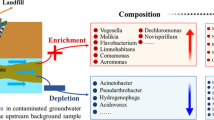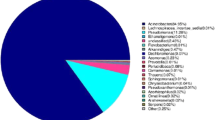Abstract
Nitrogen pollution exceeding the standard because of intensive farming and cropping systems has been a widespread problem in Northeast China. This study investigated the characteristics of functional microorganisms in groundwater in the Bang River farming area. Metagenomic sequencing was used to analyze microbial community structures and Canoco was applied to reveal the response relationship between the microbial community and water environmental factors and to identify changes in the microbial population in response to the addition of electronic donors NH4+-N, NO2−-N, and NO3−-N. The results showed that the dominant microorganisms in groundwater belong to the genera Exiguobacterium, Citrobacter, Acinetobacter, and Pseudomonas, which accounted for more than 40% of the total microbes in the study area. When combined with the results of a water chemical factor test, the dominant bacteria were found to be correlated with Fe2+, Mn2+, NH4+, NO3−, NO2−, HCO3−, DOC, and pH in the water. However, the microbial population changed after the addition of the electron donor, with the genera Pseudomonas, Serratia, Enterobacter, Azomonas, and Ewingella accounting for 97.06% of the total sequences. Indigenous nitrogen-degrading bacteria suitable for low temperature, low oxygen, and oligotrophic groundwater were screened out. The total removal efficiency of NH4+-N, NO2−-N, and NO3−-N in 120 h was 90.83%, 75.04%, and 73.35%, respectively. According to the experimental results, the degradation reaction kinetics followed a pseudo-second-order equation. The results presented herein provide an important scientific basis for the microbial remediation of groundwater contaminated by ammonia.






Similar content being viewed by others
References
Badger JL, Stins MF, Kim KS (1999) Citrobacter freundii invades and replicates in human brain microvascular endothelial cells. Infect Immun 67(8):4208–4215
Chen L, Bai J, Zhao YG, Tian WJ, Zhang Y, Dang JJ, Li KR (2016) Identification and denitrification characteristics of an aerobic denitrifier in estuary phragmites wetland. Acta Microbiol Sin 56(8):1314–1325 in Chinese
Christgen B, Yang Y, Ahammad SZ, Li B, Rodriquez C, Zhang T, Graham DW (2015) Metagenomics shows that low-energy anaerobic–aerobic treatment reactors reduce antibiotic resistance gene levels from domestic wastewater. Environ Sci Technol 49(4):2577–2584
Daum M, Zimmer W, Papen H, Kloos K, Nawrath K, Bothe H (1998) Physiological and molecular biological characterization of ammonia oxidation of the heterotrophic nitrifier Pseudomonas putida. Curr Microbiol 37(4):281–288
Du Q, Liu S, Cao Z, Wang YQ (2005) Ammonia removal from aqueous solution using natural Chinese clinoptilolite. Sep Purif Technol 44(3):229–234
Fu DF, Kai H, Singh RP, Ducoste JJ (2014) Enhanced nitrogen removal by rice husk amended dynamic membrane bioreactors. Journal of Environmental Engineering, 140(11):04014035
Gao JF, Luo X, Wu GX, Li T, Peng YZ (2014) Abundance and diversity based on amoA genes of ammonia-oxidizing archaea and bacteria in ten wastewater treatment systems. Appl Microbiol Biotechnol 98(7):3339–3354
Gulis G, Czompolyova M, Cerhan JR (2002) An ecologic study of nitrate in municipal drinking water and cancer incidence in Trnava District, Slovakia. Environ Res 88(3):182–187
Han R, Geller JT, Yang L, Brodie EL, Chakraborty R, Larsen JT, Beller HR, (2010) Physiological and Transcriptional Studies of Cr(VI) Reduction under Aerobic and Denitrifying Conditions by an Aquifer-Derived Pseudomonad. Environmen Sci Technol 44(19):7491–7497
Hou J, Song C, Cao X, Zhou Y (2013) Shifts between ammonia-oxidizing bacteria and archaea in relation to nitrification potential across trophic gradients in two large Chinese lakes (lake Taihu and lake Chaohu). Water Res 47(7):2285–2296
Hou GH, Liu F, Liu MZ (2014) Performance of a permeable reactive barrier for in situ removal of ammonium in groundwater. Water Sci Technol-Water Supply 14(4):585–592
Huang GX, Liu F, Yang YZ, Deng W, L SP, Huang YY, Kong XK (2015) Removal of ammonium-nitrogen from groundwater using a fully passive permeable reactive barrier with oxygen-releasing compound and clinoptilolite. J Environ Manag 154(1):1–7
Jia SY, Wang Z, Zhang XX, Liu B, Cheng SP (2013) Metagenomic analysis of cadmium and copper resistance genes in activated sludge of a tannery wastewater treatment plant. J Environ Biol 34(S2):375–380
Kouki S, Saidi N, M”Hiri F, Nasr H, Cherif H, Ouzari H (2011) Isolation and characterization of facultative mixotrophic ammonia-oxidizing bacteria from constructed wetlands. J Environ Sci 23(10):1699–1708
Li S, Zhang YL, Qian H, Deng ZQ, Wang X, Yin SQ (2019) Removal characteristics of a composite active medium for remediation of nitrogen-contaminated groundwater and metagenomic analysis of degrading bacteria. Environ Pollut 254:1–12
Liu GD, Wu WL, Zhang J (2005) Regional differentiation of non-point source pollution of agriculture-derived nitrate nitrogen in groundwater in northern China. Agric Ecosyst Environ 107(2–3):211–220
Liu H, Sun YF, Zhou KQ, Gu XT, Chen JM (2011) Change of denitrifying phosphate bacteria(DPB) in sludge bio-membrane system using PCR-DGGE method. J Cent South Univ (Science and Technology) 42(4):1167–1174 in Chinese
Liu JF, Zhou T, Liu ZH,Cheng SM (2014) Screening and identification of a new heterotrophic nitrifying bacteria and characterization of nitrification. Environ Sci Technol 37(8):99–103 in Chinese
Luo LX, Huan L, Feng W (2014) Screening and denitrification performance of denitrifying bacteria in constructed rapid infiltration system. Environ Eng 32(4):9–13 in Chinese
Narciso-Da-Rocha C, Vaz-Moreira I, Svensson-Stadler L, Moore ERB, Manaia Célia M (2013) Diversity and antibiotic resistance of Acinetobacter spp. in water from the source to the tap. Appl Microbiol Biotechnol 97(1):329–340
Nikolaidis NP, Heng H, Semagin R, Clausen JC (1998) Non-linear response of a mixed land use watershed to nitrogen loading. Agric Ecosyst Environ 67(2–3):251–265
O’Mahony MM, Dobson ADW, Barnes JD, Singleton I (2006) The use of ozone in the remediation of polycyclic aromatic hydrocarbon contaminated soil. Chemosphere. 63(2):307–314
Racz L, Datta T, Goel R (2010) Effect of organic carbon on ammonia oxidizing bacteria in a mixed culture. Bioresour Technol 101(16):6454–6460
Seeger EM, Kuschk P, Fazekas H, Grathwohl P, Kaestner M (2011) Bioremediation of benzene-, MTBE- and ammonia-contaminated groundwater with pilot-scale constructed wetlands. Environ Pollut 159(12):3769–3776
Shi P, Jia SY, Zhang XX, Zhang T, Cheng SP, Li A (2013) Metagenomic insights into chlorination effects on microbial antibiotic resistance in drinking water. Water Res 47(1):111–120
Shoun H, Kim DH, Uchiyama H, Sugiyama J (1992) Denitrification by fungi. FEMS Microbiol Lett 94(3):277–281
Shoun H, Kano M, Baba I, Takaya N, Matsuo M (1998) Denitrification by Actinomycetes and purification of dissimilatory nitrite reductase and azurin from Streptomyces thioluteus. J Bacteriol 180(17):4413–4415
Spalding RF, Exner ME (1993) Occurrence of nitrate in groundwater. J Environ Qual 22(3):392–402
Su JJ, Yeh KS, Tseng PW (2006) A strain of Pseudomonas sp. isolated from piggery wastewater treatment systems with heterotrophic nitrification capability in Taiwan. Curr Microbiol 53:77–81
Wang Y, Kmiya Y, Okuhara T (2007) Removal of low-concentration ammonia in water by ion-exchange using Na-mordenite. Water Res 41(2):269–276
Wang HJ, Zhou YL, Wang XQ, Hu MD (2016) Isolation, identification and immobilization of nitrobacteria and the ammonia nitrogen removal efficiency of immobilized nitrobacteria particles. Environ Pollut Control 38(11):43–46 in Chinese
White RA, Grassa CJ, Suttle CA (2013) Draft genome sequence of Exiguobacterium pavilionensis strain RW-2, with wide thermal, salinity, and pH tolerance, isolated from modern freshwater microbialites. Genome Announc 1(4):e00597–e00513
Wu J (2010) Study on groundwater pollution and its control strategies in Baotou city. Inner Mongolia University, in Chinese
Xia SQ, Li JX, Wang RC, Li JY, Zhang ZQ (2010) Tracking composition and dynamics of nitrification and denitrification microbial community in a biofilm reactor by PCR-DGGE and combining FISH with flow cytometry. Biochem Eng J 49(3):370–378
Xu XJ, Chen C, Wang AJ, Yu H, Zhou X, Guo HL, Yuan Y, Lee JZ, Zhou JZ, Ren NQ (2014) Bioreactor performance and functional gene analysis of microbial community in a limited-oxygen fed bioreactor for co-reduction of sulfate and nitrate with high organic input. J Hazard Mater 278:250–257
Yasuda T, Waki M, Fukumoto Y, Hanajima D, Kuroda K, Suzuki K, Matsumoto T, Uenishi H (2017) Community structure of denitrifying and total bacteria during nitrogen accumulation in an ammonia-loaded biofilter. J Appl Microbiol 123(6):1498–1511
Ye L, Zhang T, Wang T, Fang Z (2012) Microbial structures, functions, and metabolic pathways in wastewater treatment bioreactors revealed using high-throughput sequencing. Environ. Sci. Technol. 46(24):13244–13252
Zeng T, Li D, Zhang J (2011) Characterization of the microbial community in a partial nitrifying sequencing batch biofilm reactor. Curr Microbiol 63(6):543–550
Zuo R, Chen X, Li X, Shan D, Yang J, Wang J, Teng Y (2017) Distribution, genesis, and pollution risk of ammonium nitrogen in groundwater in an arid loess plain, northwestern China. Environ Earth Sci 76:629
Acknowledgments
This study was supported by the Major Science and Technology Program for Water Pollution Control and Treatment (2014ZX07201010).
Author information
Authors and Affiliations
Corresponding author
Additional information
Responsible editor: Robert Duran
Publisher’s note
Springer Nature remains neutral with regard to jurisdictional claims in published maps and institutional affiliations.
Electronic supplementary material
ESM 1
(DOCX 1201 kb)
Rights and permissions
About this article
Cite this article
Li, S., Zhang, Y., Yin, S. et al. Analysis of microbial community structure and degradation of ammonia nitrogen in groundwater in cold regions. Environ Sci Pollut Res 27, 44137–44147 (2020). https://doi.org/10.1007/s11356-020-10318-w
Received:
Accepted:
Published:
Issue Date:
DOI: https://doi.org/10.1007/s11356-020-10318-w




